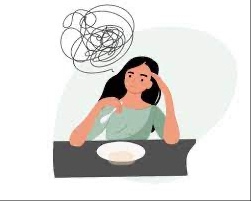Types of Eating Disorders

What are Eating Disorders?
Eating Disorders are serious mental and physical disorders characterized by the disturbance in eating accompanied by difficult persistent thoughts and emotions related to food or body image. They affect 9% of the population including men and women, and people of all ages and backgrounds(2). They are also the second most deadly mental illness behind Opioid Addiction(2). Common eating disorders include Anorexia Nervosa (AN), Bulimia Nervosa (BN), Binge Eating Disorder (BED), Avoidant Restrictive Food Intake Disorder (ARFID), and Other Specified Feeding and Eating Disorders (OSFED). One common misconception about eating disorders is that they are lifestyle choices, when in reality they are biologically influenced stress and anxiety disorders. While Eating Disorders can be scary, they are treatable and most people do recover.
Types of Eating Disorders
Anorexia Nervosa
According to the National Eating Disorders Association (NEDA), some signs and symptoms of Anorexia Nervosa may include: dramatic weight loss, dressing in layers to hide weight loss or to keep warm, preoccupation with weight, food, calories, fat grams, dieting, making frequent comments about feeling “fat,” maintaining an excessive and rigid exercise regime, hiding food, avoiding eating in front of others, low energy, lack of concentration, and dizziness (5). According to the Diagnostic and Statistical Manual of Mental Disorders V (DSM-V), Anorexia Nervosa is characterized by the following:
• Restriction of energy intake relative to requirements leading to a significantly low body weight in the context of age, sex, developmental trajectory, and physical health.
• Intense fear of gaining weight or becoming fat, even though underweight.
• Disturbance in the way in which one’s body weight or shape is experienced, undue influence of body weight or shape on self-evaluation, or denial of the seriousness of low body weight (1).
While the DSM-V diagnostic criteria for Anorexia Nervosa includes stipulations regarding a person’s weight, it is now widely understood that most people struggling with Anorexia Nervosa do not have low body weight (2), yet still may experience effects of malnutrition and psychological disturbance due to Anorexia. Symptoms of Anorexia Nervosa without low body weight is typically referred to as “Atypical Anorexia.”
Bulimia Nervosa
Bulimia Nervosa includes recurrent episodes of binge eating followed by a compensation behavior which may include self-induced vomiting (purging), the use of laxatives, or exercise. Many people with Bulimia Nervosa may be stuck in a restrict/binge/purge cycle. Some signs and symptoms of BN include:
• Evidence of binge eating, including disappearance of large amounts of food in short periods of time or lots of empty wrappers and containers indicating consumption of large amounts of food
• Evidence of purging behaviors, including frequent trips to the bathroom after meals, signs and/or smells of vomiting, presence of wrappers or packages of laxatives or diuretics
• Drinks excessive amounts of water or non-caloric beverages, and/or uses excessive amounts of mouthwash, mints, and gum
• Has calluses on the back of the hands and knuckles from self- induced vomiting
• Dental problems, such as enamel erosion, cavities, discoloration of teeth from vomiting, and tooth sensitivity
• Recurrent raspy voice (5)
Binge Eating Disorder
Like Bulimia Nervosa, Binge Eating Disorder includes episodes of binge eating, but does not typically follow with a compensation behavior. Binge eating episodes are associated with three or more of the following:
• Eating much more rapidly than normal
• Eating large amounts of food when not feeling physically hungry
• Eating until feeling uncomfortably full
• Eating alone because you are embarrassed by how much you’re eating
• Feeling disgusted with oneself, depressed, or very guilty after overeating
• Marked distress regarding binge eating (1)
In order to meet criteria for BED, binge eating episodes must occur on average at least one time per week for three months(1). It is important to note that several other eating disorders include episodes of binge eating but are not classified as Binge Eating Disorder, including in Anorexia Nervosa.
Avoidant Restrictive Food Intake Disorder (ARFID)
Avoidant Restrictive Food Intake Disorder, also known as ARFID, differs from other eating disorders in that the fear and avoidance of food is not related to body image disturbance or fear of gaining weight. Symptoms of ARFID may include:
• Dramatic reduction of intake
• Lack of interest in food
• Weight loss
• Limited range of preferred foods that becomes narrower over time (i.e., picky eating
that progressively worsens)
• Fears of choking, vomiting, or being uncomfortably full (1)
ARFID is often related to the fear of food itself, extreme discomfort with certain types of food textures, or fear of what food could do to the body such as cause choking, vomiting, or uncomfortable feelings of fullness. In order to avoid discomfort, people with ARFID avoid the food perceived to cause the discomfort. As ARFID progresses, more and more food types may be restricted. Complications of ARFID can look like medical complications seen in Anorexia Nervosa including low body weight, nutritional deficiencies, and Bradycardia.
Other Specified Feeding and Eating Disorders (OSFED)
Other Specified Feeding and Eating Disorders, or OSFED, is the most common eating disorder diagnosis. While the DSM-V has specific criteria for identifying and diagnosing certain types of eating disorders, it’s important to note that often these definitions are too narrow and do not encompass the experience of many with eating disorders. OSFED is diagnosed in people who often have disordered eating habits, disturbed body image, and distress around food and weight, but do not meet specific criteria for other eating disorders. A diagnosis of OSFED does not mean it is a less severe eating disorder than the others. Some examples of OSFED include: Bulimia or BED with low frequency or limited duration, purging disorder (BN without binges), Atypical Anorexia (all the symptoms of Anorexia without significant weight loss), Orthorexia (extreme focus on the quality of food, rigid diet rules, fear of disease from unhealthy eating) and Compulsive Exercise (exercise that interferes with normal life, happens at inappropriate times, and exercise despite illness or injury).
Seeking Treatment
Seeking help for an eating disorder can be a difficult step for those who suffer because of shame and stigma surrounding eating disorders. We want you to know that having an eating disorder is not your fault, and you deserve treatment to live a happy and fulfilled life. At Whole Hive Counseling, we offered specialized care for eating disorder treatment for men, women, teens, and adults. If you’re ready to begin your journey of healing, please reach out to us at [email protected]. We’d be happy to talk with you, answer your questions, and see if our services would be a good fit for you.
Resources
1. CBS Publishers & Distributors, Pvt. Ltd. (2017). Diagnostic and statistical manual of mental disorders: Dsm-5.
2. Eating disorder statistics: General & Diversity stats: Anad. National Association of Anorexia Nervosa and Associated Disorders. (2023, February 6). Retrieved February 25, 2023, from https://anad.org/eating-disorders-statistics
3. Orthorexia. (2019, December 13). National Eating Disorders Association.
4. Eating Disorder Statistics. (2021). National Association of Anorexia Nervosa and Related Disorders.
5. Warning signs and symptoms. National Eating Disorders Association. (2017, February 26). Retrieved February 25, 2023, from https://www.nationaleatingdisorders.org/learn/by-eating-disorder/anorexia/warning-signs-symptoms
6. What are eating disorders? (2021, March). American Psychiatric Association. Retrieved October 3, 2022.

